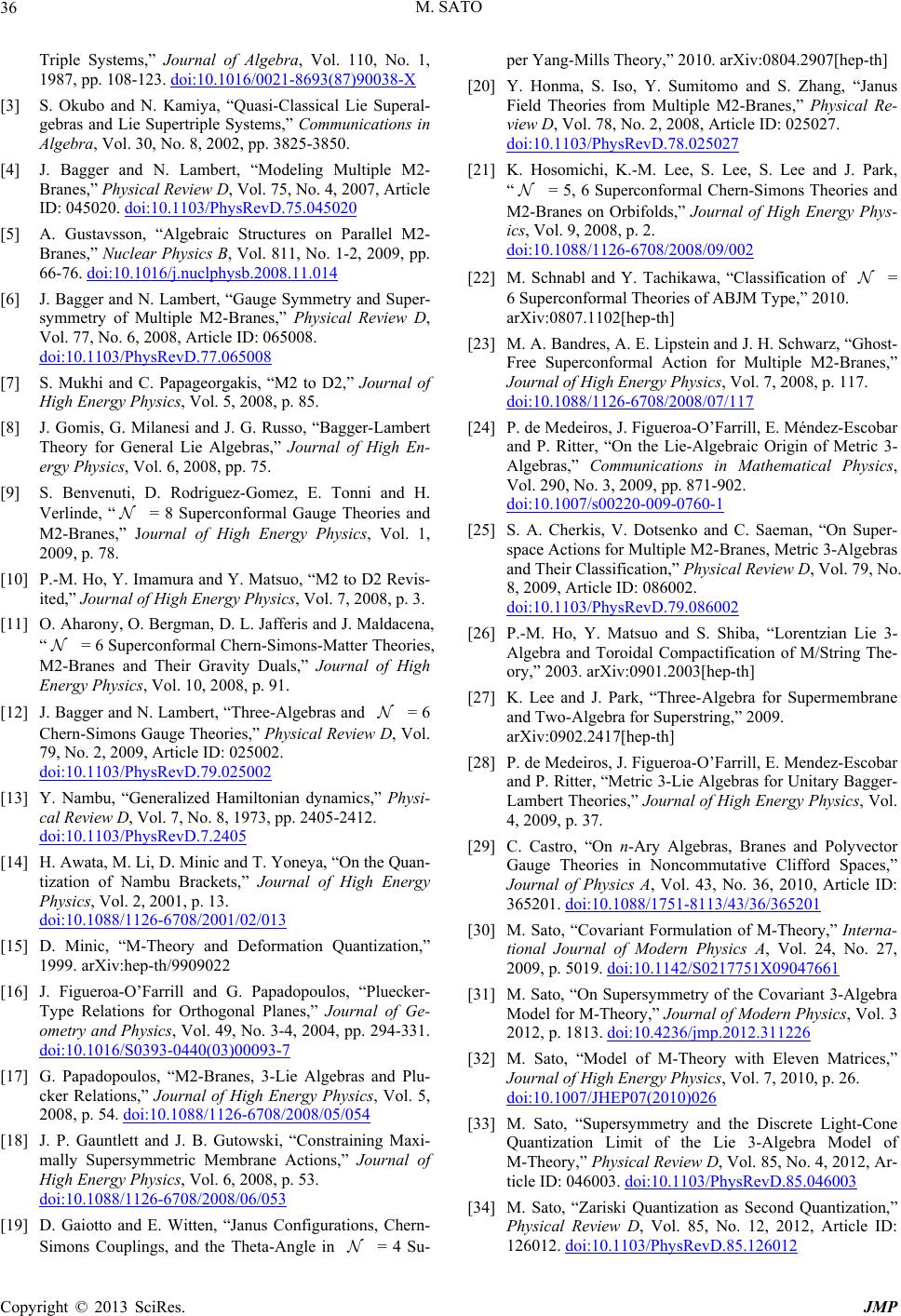
M. SATO
36
Triple Systems,” Journal of Algebra, Vol. 110, No. 1,
1987, pp. 108-123. doi:10.1016/0021-8693(87)90038-X
[3] S. Okubo and N. Kamiya, “Quasi-Classical Lie Superal-
gebras and Lie Supertriple Systems,” Communications in
Algebra, Vol. 30, No. 8, 2002, pp. 3825-3850.
[4] J. Bagger and N. Lambert, “Modeling Multiple M2-
Branes,” Physical Review D, Vol. 75, No. 4, 2007, Article
ID: 045020. doi:10.1103/PhysRevD.75.045020
[5] A. Gustavsson, “Algebraic Structures on Parallel M2-
Branes,” Nuclear Physics B, Vol. 811, No. 1-2, 2009, pp.
66-76. doi:10.1016/j.nuclphysb.2008.11.014
[6] J. Bagger and N. Lambert, “Gauge Symmetry and Super-
symmetry of Multiple M2-Branes,” Physical Review D,
Vol. 77, No. 6, 2008, Article ID: 065008.
doi:10.1103/PhysRevD.77.065008
[7] S. Mukhi and C. Papageorgakis, “M2 to D2,” Journal of
High Energy Physics, Vol. 5, 2008, p. 85.
[8] J. Gomis, G. Milanesi and J. G. Russo, “Bagger-Lambert
Theory for General Lie Algebras,” Journal of High En-
ergy Physics, Vol. 6, 2008, pp. 75.
[9] S. Benvenuti, D. Rodriguez-Gomez, E. Tonni and H.
Verlinde, “ = 8 Superconformal Gauge Theories and
M2-Branes,” Journal of High Energy Physics, Vol. 1,
2009, p. 78.
[10] P.-M. Ho, Y. Imamura and Y. Matsuo, “M2 to D2 Revis-
ited,” Journal of High Energy Physics, Vol. 7, 2008, p. 3.
[11] O. Aharony, O. Bergman, D. L. Jafferis and J. Maldacen a,
“ = 6 Superconformal Chern-Simons-Matter Theories,
M2-Branes and Their Gravity Duals,” Journal of High
Energy Physics, Vol. 10, 2008, p. 91.
[12] J. Bagger and N. Lambert, “Three-Algebras and = 6
Chern-Simons Gauge Theories,” Physical Review D, Vol.
79, No. 2, 2009, Article ID: 025002.
doi:10.1103/PhysRevD.79.025002
[13] Y. Nambu, “Generalized Hamiltonian dynamics,” Physi-
cal Review D, Vol. 7, No. 8, 1973, pp. 2405-2412.
doi:10.1103/PhysRevD.7.2405
[14] H. Awata, M. Li, D. Minic and T. Yoneya, “On the Quan-
tization of Nambu Brackets,” Journal of High Energy
Physics, Vol. 2, 2001, p. 13.
doi:10.1088/1126-6708/2001/02/013
[15] D. Minic, “M-Theory and Deformation Quantization,”
1999. arXiv:hep-th/9909022
[16] J. Figueroa-O’Farrill and G. Papadopoulos, “Pluecker-
Type Relations for Orthogonal Planes,” Journal of Ge-
ometry and Physics, Vol. 49, No. 3-4, 2004, pp. 294-331.
doi:10.1016/S0393-0440(03)00093-7
[17] G. Papadopoulos, “M2-Branes, 3-Lie Algebras and Plu-
cker Relations,” Journal of High Energy Physics, Vol. 5,
2008, p. 54. doi:10.1088/1126-6708/2008/05/054
[18] J. P. Gauntlett and J. B. Gutowski, “Constraining Maxi-
mally Supersymmetric Membrane Actions,” Journal of
High Energy Physics, Vol. 6, 2008, p. 53.
doi:10.1088/1126-6708/2008/06/053
[19] D. Gaiotto and E. Witten, “Janus Configurations, Chern-
Simons Couplings, and the Theta-Angle in = 4 Su-
per Yang-Mills Theory,” 2010. arXiv:0804.2907[hep-th]
[20] Y. Honma, S. Iso, Y. Sumitomo and S. Zhang, “Janus
Field Theories from Multiple M2-Branes,” Physical Re-
view D, Vol. 78, No. 2, 2008, Article ID: 025027.
doi:10.1103/PhysRevD.78.025027
[21] K. Hosomichi, K.-M. Lee, S. Lee, S. Lee and J. Park,
“ = 5, 6 Superconformal Chern-Simons Theories and
M2-Branes on Orbifolds,” Journal of High Energy Phys-
ics, Vol. 9, 2008, p. 2.
doi:10.1088/1126-6708/2008/09/002
[22] M. Schnabl and Y. Tachikawa, “Classification of =
6 Superconformal Theories of ABJM Type,” 2010.
arXiv:0807.1102[hep-th]
[23] M. A. Bandres, A. E. Lipstein and J. H. Schwarz, “Ghost-
Free Superconformal Action for Multiple M2-Branes,”
Journal of High Energy Physics, Vol. 7, 2008, p. 117.
doi:10.1088/1126-6708/2008/07/117
[24] P. de Medeiros, J. Figueroa-O’Farrill, E. Méndez-Escobar
and P. Ritter, “On the Lie-Algebraic Origin of Metric 3-
Algebras,” Communications in Mathematical Physics,
Vol. 290, No. 3, 2009, pp. 871-902.
doi:10.1007/s00220-009-0760-1
[25] S. A. Cherkis, V. Dotsenko and C. Saeman, “On Super-
space Actions for Multiple M2-Branes, Metric 3-Algebras
and Their Classification,” Physical Review D, Vol. 79, No.
8, 2009, Article ID: 086002.
doi:10.1103/PhysRevD.79.086002
[26] P.-M. Ho, Y. Matsuo and S. Shiba, “Lorentzian Lie 3-
Algebra and Toroidal Compactification of M/String The-
ory,” 2003. arXiv:0901.2003[hep-th]
[27] K. Lee and J. Park, “Three-Algebra for Supermembrane
and Two-Algebra for Superstring,” 2009.
arXiv:0902.2417[hep-th]
[28] P. de Medeiros, J. Figueroa-O’Farrill, E. Mendez-Escobar
and P. Ritter, “Metric 3-Lie Algebras for Unitary Bagger-
Lambert Theori es,” Journal of High Energy Physics, Vol.
4, 2009, p. 37.
[29] C. Castro, “On n-Ary Algebras, Branes and Polyvector
Gauge Theories in Noncommutative Clifford Spaces,”
Journal of Physics A, Vol. 43, No. 36, 2010, Article ID:
365201. doi:10.1088/1751-8113/43/36/365201
[30] M. Sato, “Covariant Formulation of M-Theory,” Interna-
tional Journal of Modern Physics A, Vol. 24, No. 27,
2009, p. 5019. doi:10.1142/S0217751X09047661
[31] M. Sato, “On Supersymmetry of the Covariant 3-Algebra
Model f or M-Theo ry, ” Journal of Modern Physics, Vol. 3
2012, p. 1813. doi:10.4236/jmp.2012.311226
[32] M. Sato, “Model of M-Theory with Eleven Matrices,”
Journal of High Energy Physics, Vol. 7, 2010, p. 26.
doi:10.1007/JHEP07(2010)026
[33] M. Sato, “Supersymmetry and the Discrete Light-Cone
Quantization Limit of the Lie 3-Algebra Model of
M-Theory,” Physical Review D, Vol. 85, No. 4, 2012, Ar-
ticle ID: 046003. doi:10.1103/PhysRevD.85.046003
[34] M. Sato, “Zariski Quantization as Second Quantization,”
Physical Review D, Vol. 85, No. 12, 2012, Article ID:
126012. doi:10.1103/PhysRevD.85.126012
Copyright © 2013 SciRes. JMP